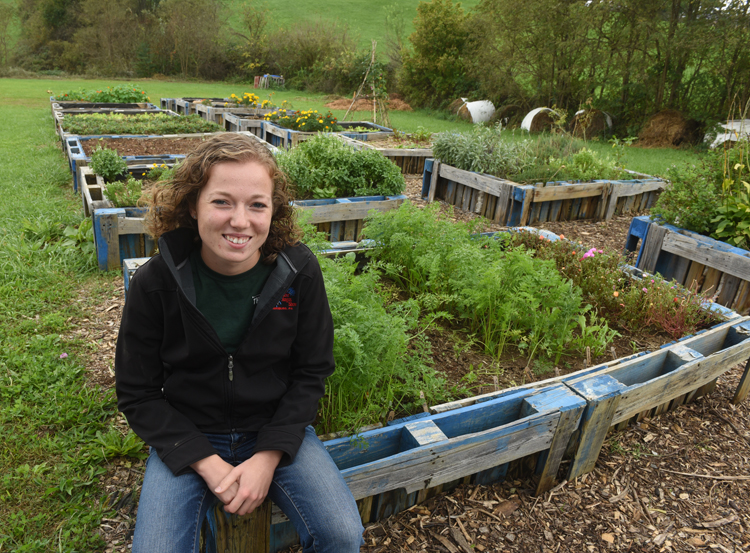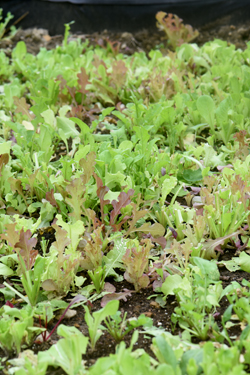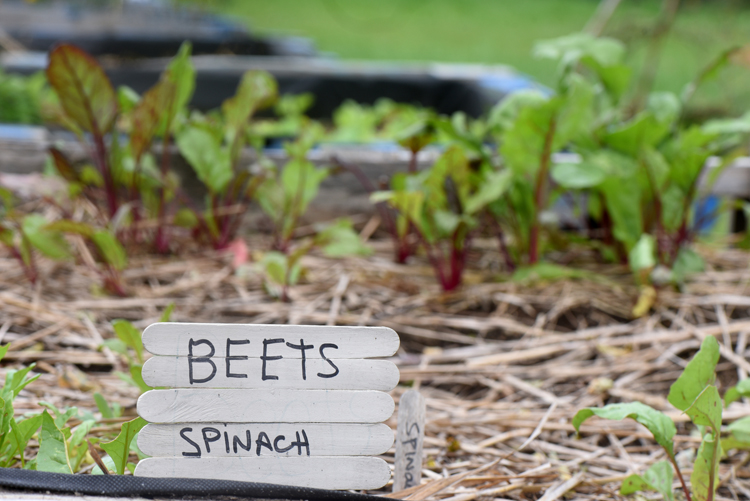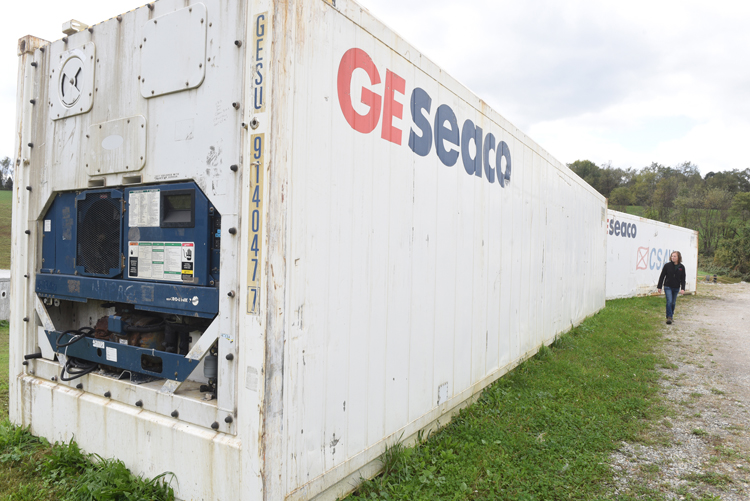Food bank garden helps the hungry, shipping container project will feed more
Posted on: October 18, 2018 | Written By: Doug Oster |
Morgan Livingston’s official title at the Greater Washington County Food Bank is agricultural innovations manager.
“I’m basically the farm manager though,” she says with a smile.
But innovation abounds at the food bank, starting with its first vegetable garden behind the large warehouse and thrift store, along with big plans to develop the 24 acres, an exciting new hydroponic project along with the current orchard of fruit trees.
The vegetable garden consists of 15 raised beds made from shipping pallets. More than 450 pounds of food was harvested and given to clients in the initial season.

Morgan Livingston is agricultural innovations manager at the Greater Washington County Food Bank. She looks over the raised beds at the garden behind the food bank. Over 450 pounds of produce came out of the garden for clients. Photos by Doug Oster

A raised bed behind the Greater Washington County Food Bank is still filled with lettuce.
Everything else the food bank provides is critical to helping the hungry, but this fresh produce offers something special.
“The first few weeks when the produce started going out to the pantries, we got lots of good feedback,” Livingston says. “People were excited.”
With the help of volunteers, Livingston grew herbs, potatoes, tomatoes, peppers, lettuce, beets, beans and more. The garden was still filled last week with cool weather crops including lush deep green basil plants, colorful edible nasturtiums, red-stemmed beets and other crops.
“There needs to be emergency food service, non perishable goods that are shelf stable,” she says. “But we also wanted to offer healthier local foods and this also allows us bring in an educational component.”
That includes workshops for the public, school field trips and other programs to bring the community out and teach them where their food comes from as well as the basics of gardening. The food bank also acts as a training center with indoor classes and even a kitchen to teach people how to use the food they receive.
Earlier in the season, donated seeds and seedlings were given to their clients in hopes they could grow their own food. There were even some ‘Ghost Pepper’ plants that drew interest as it’s one of the hottest peppers in the world.
“I’m really encouraged by how receptive people are,” Livingston says. “They want to grow more of their own food, they want to be more self-reliant. We can just help with some of those tools.”

Beets and spinach were grown in this bed at the Greater Washington County Food Bank. The beets are still growing strong as the weather cools.
Straw and mulch were used as the first layer to fill the raised beds at the food bank, then a topsoil and compost mix was used as a planting medium. Livingston will continue to amend the soil each season to make it more fertile and friable.
‘Black Cherry’ and ‘Brad’s Atomic Grape’ tomatoes thrived in five-gallon containers. The former is a new introduction from Baker Creek Heirloom Seeds that produces elongated, large cherry tomatoes in clusters. They are covered in colorful stripes of lavender that transform when reopening to olive green, red, and brown blue stripes when ready. Burpee’s ‘Big Boy’ tomato also did well, but like most tomatoes, struggled with fungal issues during this wet season.
“With farming and gardening, you win some and lose some,” the 25 year-old says with a smile.
She grew up on a family farm in York County, went to school for social work thinking she should have an off-the-farm job. Finding her way to the food bank seemed like a natural progression.
“I enjoy helping people in need,” Livingston adds.
The garden she tended with help also provided lots of ‘National Pickling’ cucumber and ‘Sweet Banana’ peppers. Most of the peppers were pulled out at the end of the season even though they were still producing well into October.
“We experimented with a little bit of everything out there,” Livingston says.
More vegetables will be grown next season, and there’s hope for a greenhouse, all in an effort to get more fresh food to the 49 pantries they serve in the county. There’s always a need, and the food bank helps people make ends meet.
“In this region, we’ve seen changes in the coal industry and manufacturing,” Livingston says. “There are people who have struggled, there are a lot of working poor here. We serve a lot of elderly and children. There are a lot of people that may be working, but they can’t pay all of those bills; this is a stop gap for them. It is an important service.”
There’s a barn on the property earmarked to become an agriculture education center if funding can be secured.
Recently the Bayer Corporation donated a Ford tractor that will help the farming operation.

Morgan Livingston looks over shipping containers that will be converted into hydroponic and aquaponic systems.
The latest project Livingston is overseeing is certainly innovative. There are shipping containers sitting in the back of the food bank that will be converted into hydroponic and aquaponic systems. Fish provide fertilizer, and the plants clean the nutrient-rich solution which feeds them. The new growing areas will hopefully be ready at the end of the year and will be able to provide food year round.
“It’s a pretty efficient way to raise both fish and plants,” she says.
The project was made possible by a grant through the Pennsylvania Department of Community and Economic Development in partnership with UPMC, EQT, PNC and Northwest Bank. A company called INTAG will help with setting up the growing systems. Trinity High School nearby grows plants this way and donates produce to the food bank.
The food produced here will go to clients but also be marketed to cover operating costs.
“We’re providing healthy food,” Livingston says. “People can come see what we’re producing.”
There will be an area that shows how people can use a type of hydroponic system at home by simply using a five-gallon bucket.
“I love farming, that’s what I feel I was put on this earth to do,” Livingston says. “The fact that I can do that, but also be part of a project that’s so meaningful to the community, that’s a plus. Seeing the support of the community is very rewarding.”
Doug Oster is editor of Everybody Gardens, a website operated by 535Media, LLC. Reach him at 412-965-3278 or doster@535mediallc.com. See other stories, videos, blogs, tips and more at everybodygardens.com.
Details: gwcfb.org
The Greater Washington County Food Bank is always looking for volunteers for all aspects of their work.
More food bank stories from Everybody Gardens-
Community garden feeds the hungry.